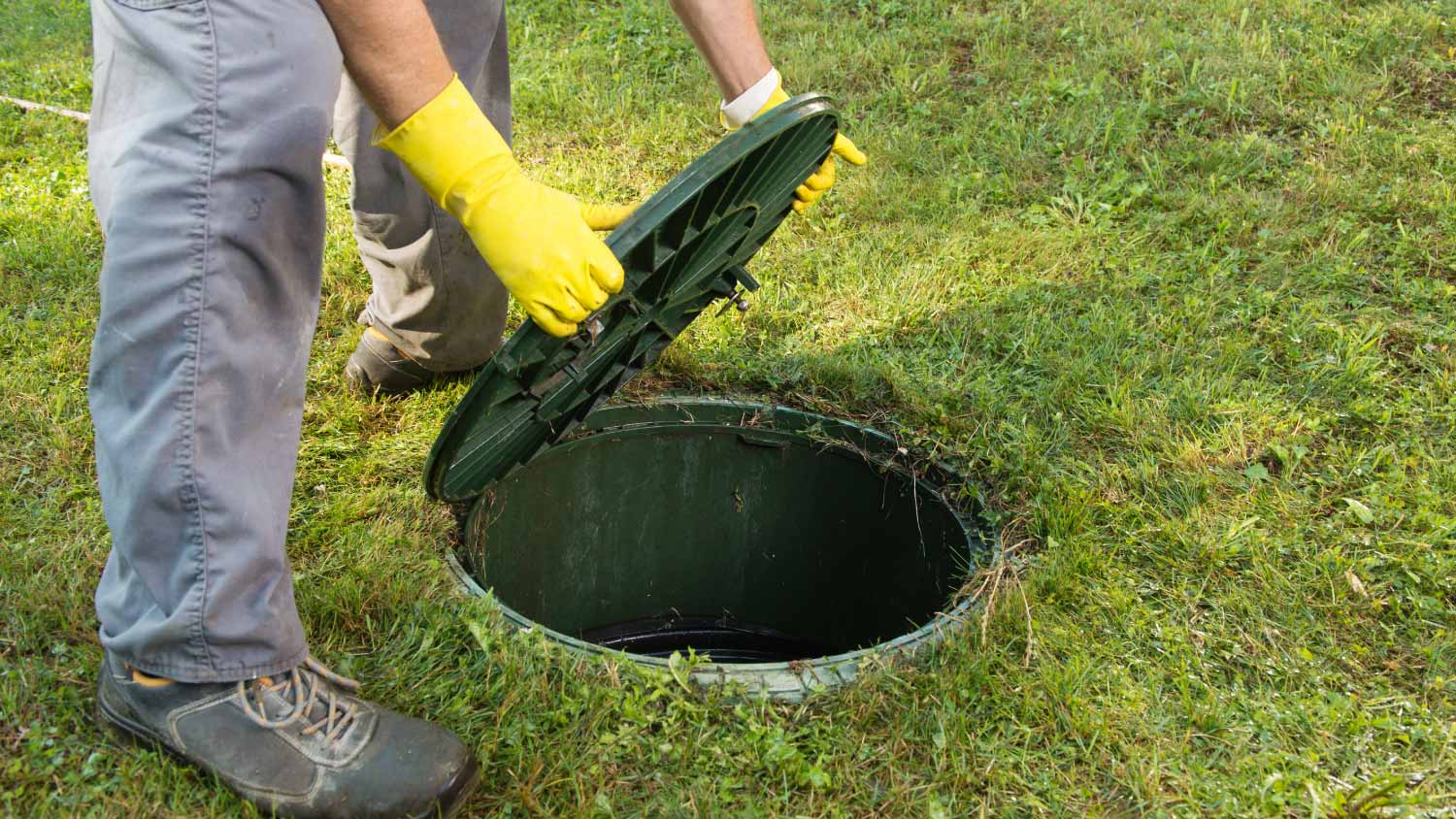
Replacing a drain field requires digging up quite a bit of land and involves a decent amount of testing. Using this guide, you’ll learn how much it costs to replace a drain field based on a few key factors such as size and type of septic system.
Finding the lid doesn’t have to cause a big stink


Opening or handling a septic tank yourself can expose you to raw sewage and toxic gases, health risks you can avoid by hiring an expert.
Calling a septic tank company to find your tank lid costs around $130 to $250 per hour, but they can also identify cracks and drainage issues that homeowners often overlook.
DIY mistakes, like breaking a pipe, can lead to expensive repairs or contamination of your soil and groundwater.
Maybe you’ve just moved to a new home with septic, and you want to make sure you know where all the parts of the septic system are located. Or perhaps you have a septic tank cleaning service on your calendar, but you have no idea where to tell the pros to go to access the septic tank. Knowing the location can give you some peace of mind and make cleaning services and repairs a bit quicker. Here’s how to find a septic tank lid using five different methods.
A septic tank lid covers a septic tank. Homes that are not connected to a public sewer line, such as homes in rural areas, may have a septic tank to manage household waste. The septic tank holds wastewater and sewage that drains from the home into a tank, where it separates into solid and liquid waste.
Solid waste stays in the tank, and a local septic tank pro will come in every few years to pump out the septic tank waste, often called sludge. The septic tank lid allows access to the septic tank so that pros can pump out the sludge as needed. The liquid waste is treated and flows through to a drain field, where the treated water slowly seeps into the surrounding soil.
Locating a septic tank lid could be free if you follow some common context clues around your yard, but if you opt to use a metal probe, it could cost $20 to $40. Calling in a pro to find your septic tank lid costs $125 to $250 per hour, while septic tank repairs cost $630 to $3,025.
Keep in mind that handling the septic tank lid and performing any inspections or repairs is best left to a pro because the septic tank can expose you to raw sewage and sewer gasses. Exposure to septic system gasses can cause drowsiness, headaches, dizziness, and nausea, according to the Wisconsin Department of Health Services. Less commonly, long-term exposure to high concentrations of septic system gasses can lead to suffocation and loss of consciousness. Long story short, don’t risk it—call in a pro for all your septic jobs.
There are multiple methods for how to find a septic tank lid, depending on whether you want to explore your own yard to find it or make a few phone calls for more information. Some homes have quick, telltale signs of a septic tank lid, like a big decorative rock, while other properties may call for a metal probe to poke around until you hit the lid. Here are five ways to find your septic tank lid.
For some properties, there could be some clear signs in the yard that point you directly to the septic tank. For example, a previous homeowner may have marked the spot with a decorative rock, so check under these faux stones for the tank lid.
You may also see a spot in the yard that’s higher or lower than the rest of the yard, which could be a sign of the septic tank lid. If you live in a cold climate, you can rely on snow to let you in on the secret of where your septic tank lid is located. The septic tank lid area will be warmer, causing the snow above the lid to melt faster compared to the rest of the yard.
You can poke a metal probe into the ground until you feel resistance from the probe hitting something other than soil. The septic tank lid may be only a few inches from the surface of your yard, or it could be up to a foot deep.
Poke along every few feet around the yard. Once the metal probe makes contact, you’ve likely found the septic tank lid. If you have sprinkler lines in your yard, you shouldn’t use this method because you could accidentally pierce a sprinkler line and cause a leak. If this is the case, try using a metal detector instead.
The sewer line in your home can point you in the right direction when it comes to how to find your septic tank lid. Check for the sewer line in a basement or crawl space, and look for where it exits the house. Outside the home, the sewer line should connect to the tank about 5 to 25 feet away from the house.
After following the sewer line, you may want to combine this method with another option, such as looking for a high or low spot, checking for decorative rocks, or using a metal probe to confirm the location of the septic tank lid.
Some types of septic systems have vents either near the septic tank lid or near the sewer line, so finding the vent can lead you to the lid or sewer line, which you can follow to the lid. The vent is likely covered with a decorative rock or partially hidden with landscaping, so check under faux rocks or around flowers and bushes to see if you can locate the vent.
If you can get documents from the company that built your home or from your city, you’ll easily be able to find the septic tank lid. New homeowners will receive these documents when they purchase the home. If you don’t have these documents, you can check with your city’s health department or county registrar for paperwork on your septic system. If you have the contact information for the contractors who built your home, they may also have the documents or blueprints with details on the septic tank location.
Septic tank lids are made from a wide range of materials. Often, the lid's material will match that of the septic tank. Common types of lids include:
Plastic: Plastic septic tank lids are lightweight and relatively easy to manipulate when opening the tank. They also resist corrosion. However, one drawback of plastic lids is that they are more prone to breakage than other materials.
Concrete: Concrete is often the preferred material for septic tank lids. It's durable and can withstand more weight than a plastic lid. However, a concrete lid is heavy and can be difficult to move when you want to open the tank.
Metal: Metal septic tank lids are often made from steel. They weigh less than concrete and aren't likely to crack like plastic. However, they can rust over time and don’t have as long of a lifespan.
Fiberglass: A fiberglass lid may offer the best of all worlds. Like plastic, it's lightweight and like concrete and metal, it's strong and sturdy.
Depending on the age of your septic tank, it may have two lids:
Inlet: The inlet lid is typically the lid that is closest to your house. This is the lid you’d need to remove to check for clogs.
Outlet: The outlet lid is usually the lid that's further away. You may need to remove it to change your system's filter.

Now that you’ve located the septic tank, there’s some upkeep you can do to make it easier to access the lid and simpler for a pro to service the septic tank.
Mark the area: To avoid having to relocate the septic tank lid and keep anyone from digging over the lid, mark the spot with a decorative rock, flag, or other marker.
Mow the lawn: Make sure to keep the grass around the lid trimmed and neat for easier access in the future.
Remove weeds: Weeding the area around the lid can also make it easier to access as needed.
Watch for signs of a full tank: You need to hire a pro to pump your septic tank every three to five years. Watch for pooling water or spongy ground around the septic tank area or drain field, which are signs the septic tank is full.
According to data from Angi customers, most homeowners (32.9%) have a pro clean their septic tank every one to four years. However, 24.5% of homeowners don’t know how often they get their septic tank cleaned, and 8.8% go eight years or more between cleanings (as opposed to the recommended three to five years). If you don’t know the last time you got your system cleaned, reach out to a septic company ASAP.
You may be able to locate your septic tank without spending any money. If anything, you may want to buy a metal probe, which costs $20 to $40. Comparatively, it costs $125 to $250 per hour to hire a septic tank pro to locate the septic tank and its lid. In total, locating a septic tank costs $100 to $1,175.
While you may save some money on septic tank repairs by locating the lid yourself, keep in mind that finding the lid is as far as you should go when it comes to repairing or cleaning a septic tank. Because septic tanks hold raw sewage, they can expose you to sewage and gasses that pose health risks, like nausea, dizziness, and loss of consciousness in extreme situations. Leave this job to your local septic tank company if it’s time for a septic tank cleaning or your system needs repairs.
From average costs to expert advice, get all the answers you need to get your job done.

Replacing a drain field requires digging up quite a bit of land and involves a decent amount of testing. Using this guide, you’ll learn how much it costs to replace a drain field based on a few key factors such as size and type of septic system.

Need to know what sewer line replacement costs in Tampa, FL? This guide will help you prepare to budget for sewer line replacement done by local contractors.

How much does a septic system cost? Explore impacting factors, important add-ons, and how you can save money on septic system installation right here.

Odor problems in the laundry room? We discuss why your washing machine smells like sewage and how to fix those stinky plumbing issues.

Cleaning out clogged or dirty septic field lines is a quick job for a seasoned pro. Learn what makes up the total cost to clean septic field lines

High utility bills are often a sign of trouble. If you’re wondering, “Why is my sewer bill so high?” review this guide for potential causes and fixes.